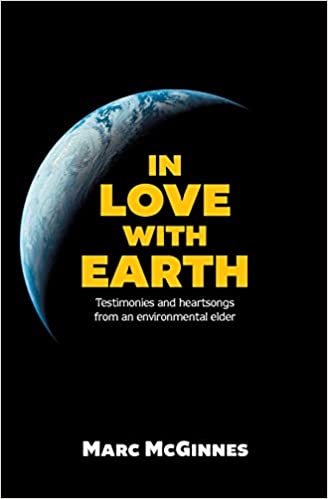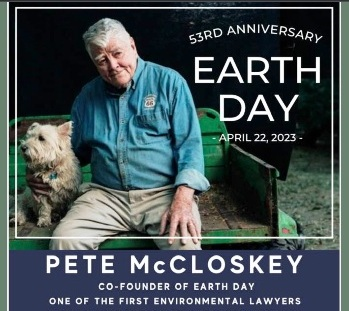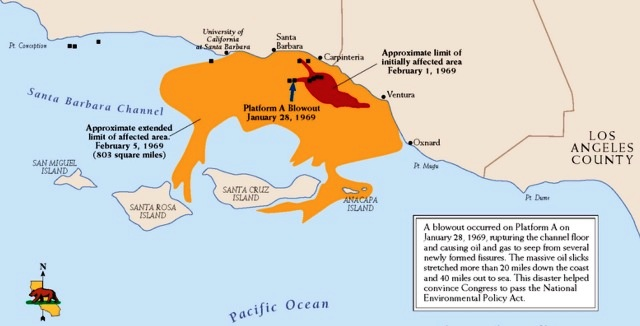File:In Love with Earth.jpg
In_Love_with_Earth.jpg (328 × 499 pixels, file size: 15 KB, MIME type: image/jpeg)
In Love with Earth
By Marc McGinnis, retired University of California, Santa Barbara professor and environmental attorney
Publisher Introduction (2018): This memoir by environmental legal pioneer Marc McGinnes chronicles his ongoing work in the environmental movement at its birthplace in Santa Barbara after the devastating 1969 oil blowout. Recounting his involvement in the conference that presented the Santa Barbara Declaration of Environmental Rights, the first Earth Day celebrations, and the creation of enduring institutions such as the Environmental Defense Center, the Community Environmental Council, and the Environmental Studies program at University of California Santa Barbara, this book is a valuable resource for anyone seeking an eyewitness account of the formative days of the environmental movement. It also tells the personal story of the author's deeply spiritual transformation from a hotshot corporate lawyer who routinely represented the rapacious power elite to environmental lawyer, mediator and teacher. Changed forever by a photograph of Earth from space and a call from his powerful mentor in Congress, the trajectory of his life is redirected towards the pursuit of environmental justice. Conversational in tone, this highly readable and inspiring volume is packed with the tales of personal connections, surprising collaborations, leaps of faith, and acts of service that constitute the author's long and successful campaign fighting for the planet he loves.
🌎
GreenPolicy360: A tip of our hat to #PlanetCitizen Marc McGinnes
The following is an excerpt from "In Love with Earth", published in 2018, written by Marc McGinnes, co-founder of the Community Environmental Council, the Environmental Defense Center, the Peaceful Resolutions Institute, the Community Mediation Council, and a longtime faculty member of the Environmental Studies Program at UCSB.
Marc McGinnes: In early March of 1969, l got a phone call that set my life on a new course.
I was in my law office in San Francisco. A case file lay open on my desk, and I held my Dictaphone, just about to record some notes, when my secretary buzzed over the intercom,
“There’s a Rep. Pete McCloskey from Washington, D.C., on the line for you.” I put down the recorder, reached for the telephone and heard Pete say, “Marc, have you heard about this oil platform blowout in Santa Barbara?”
“Hi, Pete. Yes, I read some of the news about it.”
“Well, I think you should get down there as quickly as you can and get involved. This is going to open up a whole new field of law. I’m at work right now helping to draft new legislation that will fundamentally change how governmental decisions affecting the environment are made. Young lawyers like you are going to be needed to enforce it in the courts. It’s a National Environmental Policy Act, and we want to be sure that similar state laws are enacted and enforced.”
“Yes, but...”
“No ‘buts’ about it, Marc. No time to waste. Get down there as soon as you can.”
I put down the phone, opened my arms to the heavens and whooped. I crossed the room to the window, opened it and shouted “Yes!” When I turned around, my secretary was staring at me with a mixture of alarm and astonishment.
That night, [my wife] Kathy and I decided to make the move. The next morning, I called Pete. He asked, “Do you know anybody down there, Marc? Do you have any contacts with any lawyers?”
“No. Not a soul.”
“Well, start as soon as you can. I’ll see what I can do. But I want to let you know, this is really important. We need to make sure that the word coming out of Santa Barbara is stronger than just ‘Get Oil Out!’ The bigger goal is to launch a powerful environmental protection movement across the whole country.”
Pete McCloskey was then and still is (going strong at age 90) an Earthangel, the first of many whom it has been a blessing to work with over the years to create and sustain such a movement.
The blowout at Union Oil’s Platform A occurred on January 28, 1969, and in response, the citizens of Santa Barbara were angry as hornets. They had every right to be. Before the offshore rigs were built, the locals had called for public hearings concerning the safety issues inherent to this kind of oil production. Those requests for hearings were denied by federal officials, who were in a rush to get started. The oil companies had paid millions of dollars to the federal government for the leases and, as Stewart Udall (Secretary of the Interior under Kennedy and Johnson) later explained, the government urgently needed those lease fees to help pay for the Vietnam War.
So Udall looked the other way as the oil companies moved aggressively forward with these offshore rigs, and ultimately it was Udall (undoubtedly at the direction of the president) who made the decision to approve drilling operations. That decision was premature, as the events of late January demonstrated.
The blowout, which spewed more than three million gallons of crude oil and gas into the Santa Barbara Channel, occurred when the drill being operated from the platform penetrated to a depth that was not protected by the casing needed to contain the pressure of the materials below. The oil came exploding out, reached the surface and began to spread. It continued to spread over the next several months. Winds and tide moved it about, and soon it spread all along the shore of the South Coast.
Sea life was deeply impacted. Birds were coated in oil, rendering them helplessly unable to fly or dive. The birds became emblematic of the disaster because they generated the most compelling images. Poignant scenes of oil-covered birds helped to make the spill a national media event carried by major news organizations into the homes of people across the country.
As the efforts to stop the spill failed, the damage continued and so did the news coverage. At that point in time it was the largest water pollution incident in United States history. This created a new national awareness of environmental abuse and set into motion seminal laws, policy and a change in social consciousness.
In that moment, journalism served as the fourth estate. There were several prominent journalists covering the event at the New York Times, the Chicago Tribune and the Los Angeles Times. Locally, Bob Sollen worked for the Santa Barbara News-Press, performing at the hub of this seminal event and briefing the national newspapers, sharing his photographs and accounts.
In addition to portraying the environmental devastation, the news media also covered representatives and dignitaries who visited the scene of the disaster. President Nixon arrived by helicopter, stepped out near the black gunk that had come ashore, and took pains to avoid sullying his wingtip shoes in the grime. Nixon was soon followed by Secretary of the Interior Walter Hickel and a whole host of other federal and state government officials who showed up to sternly deplore the situation. Press releases came out of governmental offices, and reporters diligently covered the saga. For months, visiting representatives and the national media audience watched the angry citizens of Santa Barbara vent their fury at the federal officials who had ignored their warnings and betrayed their trust.
The new National Environmental Policy Act (NEPA) that Pete had mentioned would require developers to assess the environmental impacts of their projects in advance and submit this information for public review and potential court approval before moving forward. Had this requirement been in effect prior to the government’s approval of the plan to begin drilling operations in the Santa Barbara Channel, the blowout on Platform A would almost certainly have been avoided.
File history
Click on a date/time to view the file as it appeared at that time.
| Date/Time | Thumbnail | Dimensions | User | Comment | |
|---|---|---|---|---|---|
| current | 19:34, 3 May 2023 |  | 328 × 499 (15 KB) | Siterunner (talk | contribs) |
You cannot overwrite this file.
File usage
The following page uses this file:
- Additional Website Resources - Linked Data - Green Best Practices
- Alternative Agriculture
- Anthropocene
- Arctic
- Atmospheric Science
- Biodiversity
- Bioneers
- Biosphere
- California
- Citizen Science
- Civil Rights
- Clean Air
- Clean Water
- Climate Change
- Climate Policy
- Democracy
- Democratization of Space
- Digital Citizen
- Digital Rights
- Earth
- Eco-ethics
- Eco-nomics
- Earth Day
- EOS eco Operating System
- Earth360
- EarthPOV
- Earth Observations
- Earth Science
- Ecofeminism
- Ecology Studies
- Economic Justice
- Education
- Election System Reform
- Energy
- Environmental Full-cost Accounting
- Environmental Laws
- Environmental Protection
- Environmental Security
- Environmental Security, National Security
- Envirosecurity
- ESA
- Externalities
- Fossil Fuels
- Greenland
- Global Security
- Global Warming
- Green Best Practices
- Green Networking
- GreenPolicy360
- Green Politics
- Health
- Human Rights
- Internet
- ISS
- Land Use
- Media
- Micro-satellites
- Microbiology
- Microorganism
- Money in Politics
- NASA
- Nature
- Natural Resources
- Natural Rights
- Networking
- New Definitions of National Security
- New Space
- Online Education
- Overview Effect
- Peace
- Planet Citizen
- Planet Citizens
- PlanetLabs
- Planet Scientist
- Planet Citizens, Planet Scientists
- Renewable Energy
- Resilience
- Rights of Nature
- Sea-Level Rise & Mitigation
- Seventh Generation Sustainability
- Social Justice
- Solar Energy
- Strategic Demands
- Sustainability
- Sustainability Policies
- ThinBlueLayer
- US Environmental Protection Agency
- Water Quality
- Whole Earth
- Wildlife
- Women's Rights
- World Wide Web
- Youth


